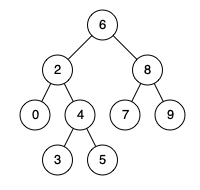给定一个二叉搜索树, 找到该树中两个指定节点的最近公共祖先。
百度百科中最近公共祖先的定义为:“对于有根树 T 的两个结点 p、q,最近公共祖先表示为一个结点 x,满足 x 是 p、q 的祖先且 x 的深度尽可能大(一个节点也可以是它自己的祖先)。”
例如,给定如下二叉搜索树: root = [6,2,8,0,4,7,9,null,null,3,5]

示例 1:
输入: root = [6,2,8,0,4,7,9,null,null,3,5], p = 2, q = 8
输出: 6
解释: 节点 2 和节点 8 的最近公共祖先是 6。示例 2:
输入: root = [6,2,8,0,4,7,9,null,null,3,5], p = 2, q = 4
输出: 2
解释: 节点 2 和节点 4 的最近公共祖先是 2, 因为根据定义最近公共祖先节点可以为节点本身。说明:
- 所有节点的值都是唯一的。
- p、q 为不同节点且均存在于给定的二叉搜索树中。
//leetcode submit region begin(Prohibit modification and deletion)
/**
* Definition for a binary tree node.
* public class TreeNode {
* int val;
* TreeNode left;
* TreeNode right;
* TreeNode(int x) { val = x; }
* }
*/
class Solution {
public TreeNode lowestCommonAncestor(TreeNode root, TreeNode p, TreeNode q) {
List<TreeNode> pPath = getPath(root, p);
List<TreeNode> qPath = getPath(root, q);
TreeNode result = null;
int index = 0;
while (index < pPath.size() && index < qPath.size()) {
if (pPath.get(index).val == qPath.get(index).val) {
result = pPath.get(index);
} else {
return result;
}
index++;
}
return result == null ? null : result;
}
private List<TreeNode> getPath(TreeNode root, TreeNode node) {
List<TreeNode> path = new ArrayList<>();
TreeNode cur = root;
while (cur != null) {
path.add(cur);
if (cur.val == node.val) {
return path;
} else if (cur.val < node.val) {
cur = cur.right;
} else {
cur = cur.left;
}
}
return path;
}
}
//leetcode submit region end(Prohibit modification and deletion)


